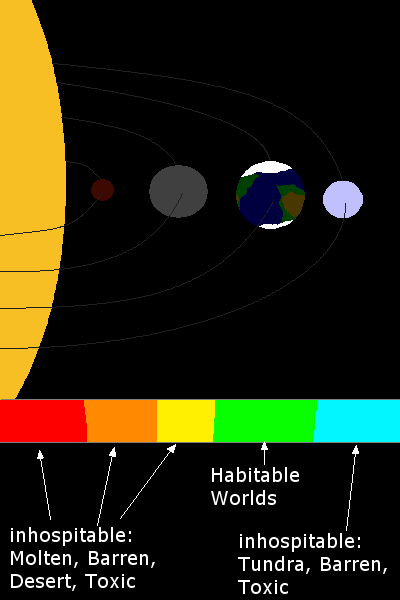|
Planets
Planetary types:Each star system will have many planets. Planets are classified as inhospitable or habitable. inhospitable planets are entirely Barren/Toxic/Molten/Desert/Tundra. Those close to the system's star will tend to be Barren, Toxic, Molten or Desert while those too far from the sun will be Tundra, Barren or Toxic. Those at the exact right distance will be habitable worlds, of type Terran, Swamp, Ocean, Tundra or Desert.The scale used will vary depending on star type, for example a brown dwarf star may be entirely blue, a hot white star may only have a tiny bit of green at the end etc.  Homeworld:An idea I've been throwing around involves homeworlds having four habitable environments. For humanoids, aquatics and hyperorganic species these would be of type Terran, Swamp, Ocean, Tundra or Desert. For Thermophillics and mechanoids, it'd be Molten, Toxic, Barren and Desert. The idea behind this was to add a first pre-warp stage to the game where you'd be exploring your own planet and researching the techs for colonising harsh environments. However, I may not go with this after all. Instead, I could just ensure the home system has appropriate planets and the pre-warp civilisation could still colonise planets in the home system.EnvironmentsEnvironments have the following attributes:
Size: Determines how many housing buildings can be built in the environment. Minerals: Determines how many drills can be built in the environment. Gravity: The same for every environment on a given planet. No effect yet. Terrain Type: Power GenerationTerran: Geothermal produces 2, Solar produces 2.Swamp: Geothermal produces 2, Solar produces 2. Ocean: Geothermal produces 0, Solar produces 2. Tundra: Geothermal produces 0, Solar produces 2. Desert: Geothermal produces 2, Solar produces 4. Barren: Geothermal produces 0, Solar produces 4. Molten: Geothermal produces 4, Solar produces 0. Toxic: Geothermal produces 2, Solar produces 0. Terrain Type: Racial variationThere is some racial variation in how the planets are suited to life. The type of housing that needs to be used to extend the planet's population, and thus the max pop available there, will differ depending on race. The amount of food that can be found in the environment is also race dependent. In the following table, Housing holds 4 pop, Biospheres hold 3 and Thermalised/Thermostatic Biospheres hold 1.Housing requirements for Humanoid races: Terran: Housing required, 4 food per farmer. Swamp: Biospheres required, 3 food per farmer. Ocean: Biospheres required, 3 food per farmer. Tundra: Thermalised Biospheres required, 1 food per farmer. Desert: Thermostatic Biospheres required, 1 food per farmer Barren: Inhospitable. Molten: Inhospitable. Toxic: Inhospitable. Housing requirements for Aquatic races: Terran: Biospheres required, 3 food per farmer. Swamp: Biospheres required, 3 food per farmer. Ocean: Housing required, 4 food per farmer. Tundra: Thermalised Biospheres required, 1 food per farmer Desert: Inhospitable. Barren: Inhospitable. Molten: Inhospitable. Toxic: Inhospitable. Housing requirements for Thermophillic races: Terran: Thermalised Biospheres required, 1 food per farmer Swamp: Thermalised Biospheres required, 1 food per farmer Ocean: Inhospitable. Tundra: Inhospitable. Desert: Thermalised Biospheres required, 1 food per farmer Barren: Thermalised Biospheres required, 1 food per farmer Molten: Housing required, 4 food per farmer. Toxic: Biospheres required, 3 food per farmer. Housing requirements for HyperOrganic races: Terran: Housing required, 4 food per farmer. Swamp: Housing required, 4 food per farmer. Ocean: Housing required, 4 food per farmer. Tundra: Inhospitable. Desert: Inhospitable. Barren: Inhospitable. Molten: Inhospitable. Toxic: Inhospitable. Mechanoid races cannot build housing. |
This website and all its contents are intellectual property of Nyphur, as determined by UK and international copyright law.
Contact Nyphur with any issues or questions you have about the site or its contents.



